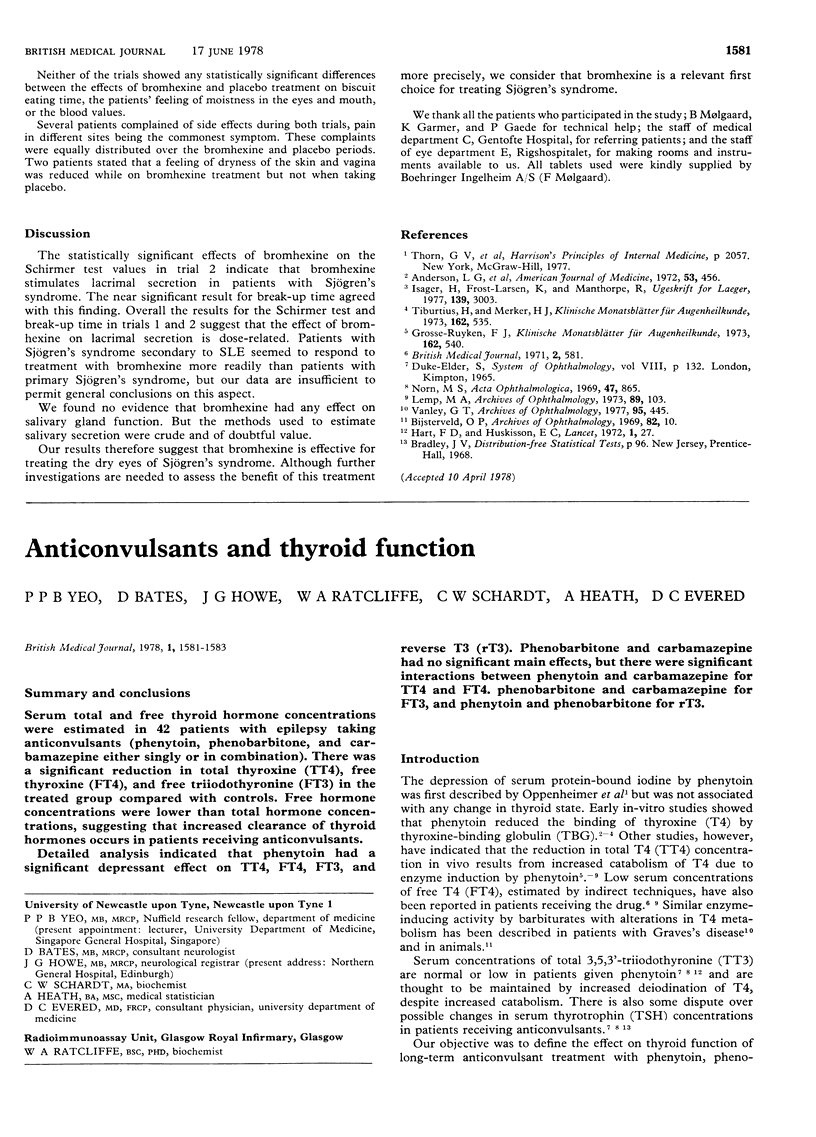Abstract
Serum total and free thyroid hormone concentrations were estimated in 42 patients with epilepsy taking anticonvulsants (phenytoin, phenobarbitone, and carbamazepine either singly or in combination). There was a significant reduction in total thyroxine (TT4), free thyroxine (FT4), and free triiodothyronine (FT3) in the treated group compared with controls. Free hormone concentrations were lower than total hormone concentrations, suggesting that increased clearance of thyroid hormones occurs in patients receiving anticonvulsants. Detailed analysis indicated that phenytoin had a significant depressant effect on TT4, FT4, FT3, and reverse T3 (rT3). Phenobarbitone and carbamazepine had no significant main effects, but there were significant interactions between phenytoin and carbamazepine for TT4 and FT4. phenobarbitone and carbamazepine for FT3, and phenytoin and phenobarbitone for rT3.
Full text
PDF


Selected References
These references are in PubMed. This may not be the complete list of references from this article.
- Cavlieri R. R., Sung L. C., Becker C. E. Effects of phenobarbital on thyroxine and triiodothyronine kinetics in Graves' disease. J Clin Endocrinol Metab. 1973 Aug;37(2):308–316. doi: 10.1210/jcem-37-2-308. [DOI] [PubMed] [Google Scholar]
- Chin W., Schussler G. C. Decreased serum free thyroxine concentration in patients treated with diphenylhydantoin. J Clin Endocrinol Metab. 1968 Feb;28(2):181–186. doi: 10.1210/jcem-28-2-181. [DOI] [PubMed] [Google Scholar]
- Evered D. C., Vice P. A., Green E., Appleton D. Assessment of thyroid hormone assays. J Clin Pathol. 1976 Dec;29(12):1054–1059. doi: 10.1136/jcp.29.12.1054. [DOI] [PMC free article] [PubMed] [Google Scholar]
- Gharib H., Munoz J. M. Endocrine manifestations of diphenylhydantoin therapy. Metabolism. 1974 Jun;23(6):515–524. doi: 10.1016/0026-0495(74)90079-1. [DOI] [PubMed] [Google Scholar]
- Hall R., Amos J., Ormston B. J. Radioimmunoassay of human serum thyrotrophin. Br Med J. 1971 Mar 13;1(5749):582–585. doi: 10.1136/bmj.1.5749.582. [DOI] [PMC free article] [PubMed] [Google Scholar]
- Hesch R. D., Evered D. Radioimmunoassay of triiodothyronine in unextracted human serum. Br Med J. 1973 Mar 17;1(5854):645–648. doi: 10.1136/bmj.1.5854.645. [DOI] [PMC free article] [PubMed] [Google Scholar]
- Larsen P. R., Atkinson A. J., Jr, Wellman H. N., Goldsmith R. E. The effect of diphenylhydantoin on thyroxine metabolism in man. J Clin Invest. 1970 Jun;49(6):1266–1279. doi: 10.1172/JCI106339. [DOI] [PMC free article] [PubMed] [Google Scholar]
- Liewendahl K., Majuri H. Thyroxine, triiodothyronine, and thyrotropin in serum during long-term diphenylhydantoin therapy. Scand J Clin Lab Invest. 1976 Mar;36(2):141–144. [PubMed] [Google Scholar]
- Lightfoot R. W., Jr, Christian C. L. Serum protein binding of thyroxine and diphenylhydantoin. J Clin Endocrinol Metab. 1966 Mar;26(3):305–308. doi: 10.1210/jcem-26-3-305. [DOI] [PubMed] [Google Scholar]
- Mendoza D. M., Flock E. V., Owen C. A., Jr, Paris J. Effect of 5,5'-diphenylhydantoin on the metabolism of L-thyroxine-131-I in the rat. Endocrinology. 1966 Jul;79(1):106–118. doi: 10.1210/endo-79-1-106. [DOI] [PubMed] [Google Scholar]
- OPPENHEIMER J. H., TAVERNETTI R. R. Studies on the thyroxine-diphenylhydantoin interaction: effect of 5,5'-diphenylhydantoin on the displacement of L-thyroxine from thyroxine-binding globulin (TBG). Endocrinology. 1962 Sep;71:496–504. doi: 10.1210/endo-71-3-496. [DOI] [PubMed] [Google Scholar]
- Oppenheimer J. H., Bernstein G., Surks M. I. Increased thyroxine turnover and thyroidal function after stimulation of hepatocellular binding of thyroxine by phenobarbital. J Clin Invest. 1968 Jun;47(6):1399–1406. doi: 10.1172/JCI105831. [DOI] [PMC free article] [PubMed] [Google Scholar]
- Ratcliffe W. A., Marshall J., Ratcliffe J. G. The radioimmunoassay of 3,3',5' - triiodothyronine (reverse T3) in unextracted human serum. Clin Endocrinol (Oxf) 1976 Nov;5(6):631–641. doi: 10.1111/j.1365-2265.1976.tb03866.x. [DOI] [PubMed] [Google Scholar]
- Toseland P. A., Grove J., Berry D. J. An isothermal GLC determination of the plasma levels of carbamazepine, diphenylhydantoin, phenobarbitone and primidone. Clin Chim Acta. 1972 May;38(2):321–328. doi: 10.1016/0009-8981(72)90122-2. [DOI] [PubMed] [Google Scholar]
- WOLFF J., STANDAERT M. E., RALL J. E. Thyroxine displacement from serum proteins and depression of serum protein-bound iodine by certain drugs. J Clin Invest. 1961 Aug;40:1373–1379. doi: 10.1172/JCI104368. [DOI] [PMC free article] [PubMed] [Google Scholar]
- Yeo P. P., Lewis M., Evered D. C. Radioimmunoassay of free thyroid hormone concentrations in the investigation of thyroid disease. Clin Endocrinol (Oxf) 1977 Feb;6(2):159–165. doi: 10.1111/j.1365-2265.1977.tb02007.x. [DOI] [PubMed] [Google Scholar]


